Facts and data on pictograms

Synonyms
Lost Property, Lost-property Office, Lost Property Service, Missing Property, Found Objects
Category
Public Facilities, Travel
Message / Function
To indicate the location of lost and found lost property facilities
| Source | Description | |
|---|---|---|
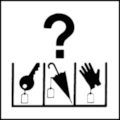 1) 1) |
Icograda | Question mark above shelve with key, umbrella, and glove, each with a tag |
 |
Icograda | Question mark above horizontal line, suitcase and hat below |
 |
Dreyfuss | Question mark, umbrella, glove, and key |
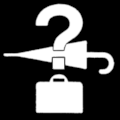 |
SEIBU | Case and umbrella with question mark superimposed |
 2) 2) |
D/FW | Question mark, hat, glove, and umbrella |
 |
Icograda | Question mark, umbrella, bag, and two keys below |
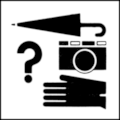 |
Icograda | Question mark plus umbrella, camera, and glove |
 |
Icograda | Umbrella, glove, and wrist watch, question mark in top right corner |
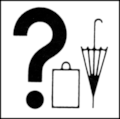 |
O'72 | Question mark left of bag and umbrella |
 |
DB | Question mark and bag above umbrella |
 |
CNIS | Question mark above left of umbrella and case |
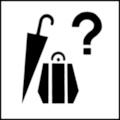 |
TC | Umbrella and bag plus question mark in top right corner |
 |
ÖBB 2007 | Question mark above umbrella and case |
 |
Eco-Mo Foundation |
Question mark above umbrella and bag |
 |
EJP | Question mark above umbrella and case |
 |
BVG | Question mark, in outline: case, and umbrella |
 |
BVG | Question mark, in outline: eye glasses, and umbrella |
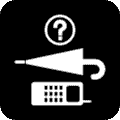 |
KSA | Question mark above umbrella and cell phone |
 |
AIGA | Question mark above umbrella and glove |
 |
Icograda | Question mark partially superimposed on hat inside square |
 |
Expo 67 | Question mark above suitcase |
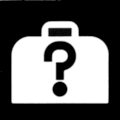 |
Expo 70 | Question mark on suitcase |
 |
PTCNSW | Umbrella above suitcase, both with label containing question mark |
 3) 3) |
SFS | Glove, suitcase and umbrella with label containing question mark |
 |
Tern | Glove, suitcase and umbrella with label containing question mark |
 |
ÖNORM A 3011 | Glove, suitcase and umbrella with label containing question mark |
 |
ISO 7001 | Glove, case and umbrella with label containing question mark |
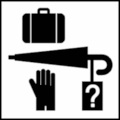 |
UIC 413 | Case, glove, umbrella with label containing question mark |
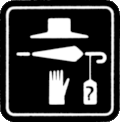 |
NS 1980 | Hat, glove, umbrella with label containing question mark |
 |
Dreyfuss | Hat, glove, umbrella with label containing question mark |
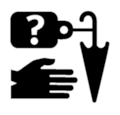 |
Givisiez | Glove, umbrella with label containing question mark |
 |
BS 8501:2002 | Umbrella with label containing question mark |
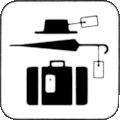 |
ATA | Hat, umbrella, and suitcase, each with label |
 |
IATA | Hat, umbrella, each with label, and glove |
 |
UIC 413 b | Hat, glove, umbrella with label |
Discussion
The collection shown above is only a small selection of the wide variety of pictograms used all over the world to signify Lost and Found. There are several general concepts and a multitude of components which indicate that there is no general stereotype to express this message. In such a case often no satisfying solution with good comprehensibility can be determined.
The concepts found, all with one ore more items typically lost like umbrella, gloves, hat, bag or case, camera or cell phone, key:
Concepts based on a suitcase and a questionmark only are inappropriate, as inquiries about delayed or missing baggage are not within the scope of this referent.
Mackett-Stout & Dewar (1981) combined a number of measures to identify the relative effectiveness of a set of graphic symbols. In the evaluation of four pictograms for Lost and Found, the variant marked TC reached the highest efficieny index, but all variants tested showed rather unsatisfactory performance.
In Appropriateness Ranking Tests conducted in the context of the Icograda student project (Frascara) and the ISO test series 1979/80 (Easterby & Graydon, 1981 a) more than 30 pictogram variants of the referent Lost and Found were examined. Three out of the best five were tested for comprehension (Easterby & Graydon, 1981 b) and all elicited significant amounts of wrong responses. The Icograda test design labeled 1) performed best with 53.6 % correct responses on basis of lenient scoring.
Another ISO test series, an international study based on Appropriateness Ranking Tests conducted in Austria (Brugger, 1984) and Sweden (Gärling, 1985), and a Comprehension Test run in Australia, Austria, Hungary, Japan, and the United Kingdom (Brugger 1987) with more than 1500 respondents followed. In the rankings the pictograms marked 1) to 3) were judged as most appropriate. The Icograda variant labeled 1) in the table above again reached the best comprehension score with 64.2 % correct answers, closely followed by the SFS pictogram labeled 3), which reached 61.5 % corresponding answers. Wrong responses were still in a range between 28.6 % and 32.2 %, and 5.6 % to 11.6 % of the respondents said they do not know what the symbol means.
In a Matching Test with a set of 29 symbols (Zwaga & Boersema, 1983) the variant from the Dutch Railways (NS 1980) reached 75.5 % correct responses. Real life performance seems to be somewhat better than comprehension/recognition test results indicated.
Later studies from Asia report improved comprehension for the concept showing two items lost plus a large question mark:
In general, results indicate that variants with more than one item perform better. Variants with no question mark, neither on a tag nor somewhere else, are rated poorer and comprehension is poor, too. The design selected should also assure a clear differentiation from the referent Cloakroom or Wardrobe.
Some statistics: In the year 1975 objects most often forgotten in Japanese trains were umbrellas, clothes and books. Fourty years later it were umbrellas, jewelry and books, followed by mobile phones. In 2021 in French trains pieces of electronic equipment were second after pieces of baggage, followed by wallets and clothes. In Austrian trains in the same year it were suitcases, bags and backpacks followed by clothes, documents and keys.
Recommendations

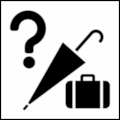
Based on test results available we recommend the use of a pictogram similar to the examples above, but there is still room for a redesign optimizing legibility and visibility.
Furthermore we recommend comparing these two concepts after optimization on basis of a Comprehension Test.
Tests of pictograms of referent Lost and Found
An, D. & Chan, E.H.W. (2017): Investigating the Comprehension of Public Symbols for Wayfinding in Transit Hubs in China. In: Rau, PL. (eds) Cross-Cultural Design. CCD 2017. Lecture Notes in Computer Science, vol 10281. Springer, Cham. https://doi.org/10.1007/978-3-319-57931-3_24
Brugger, Ch. (1984): Reihungstest 1984. Report to the Austrian Standards Institute (ON) dated 19/84, Vienna.
Brugger, Ch. (1987): Evaluation of Public Information Symbols, ISO 1986 Test Series: Comprehension/Recognition Test. WIEN: ISO/TC 145/SC 1.
Brugger, Ch. (1995): ÖBB / ON Testserie 1995, Teil 2 Verständnisschätzungen nach ISO 9186. Report to ÖBB GD 02 (Austrian Railways) dated February 1995, Vienna.
Easterby, R.S. & Graydon, I.R. (1981 a): Evaluation of Public Information Symbols: ISO Test: 1979/80 Series. Part I: Appropriateness Ranking Tests. AP Report 99, Applied Psychology Department, University of Aston in Birmingham, January 1981.
Easterby, R.S. & Graydon, I.R. (1981 b): Evaluation of Public Information Symbols: ISO 1979/80 Test Series. Part II: Comprehension/Recognition Tests. AP Report 100, Applied Psychology Department, University of Aston in Birmingham, January 1981.
Eco-Mo Foundation (2001): Test data of public information symbols in Japan - Procedure for the testing of public information symbols by the Study Committee. ISO: ISO/TC 145/SC 1 N 329.
Gärling, T. (1985): ISO Appropriateness Ranking Test 1985 - Redovisning av genomförande. Report to the Swedish Standards Institute dated 1985-07-24.
Mackett-Stout, J. & Dewar, R.L. (1981): Evaluation of Public Information Signs. Human Factors, 1981, 23, 139-151.
Zwaga, H.J. & Boersema, T. (1983): Evaluation of a set of graphic symbols. Applied Ergonomics, 14, 1, 43-54.
See also
Updated 2024-04-20 by Ch.Brugger